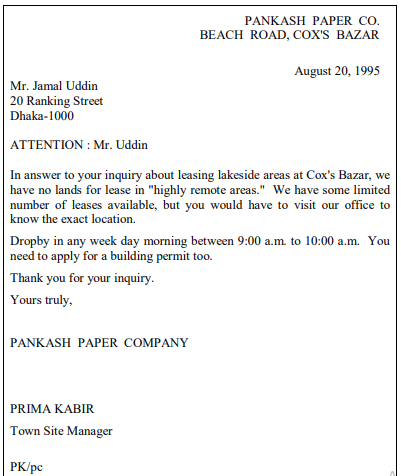UNIT-2 [ Lesson-2: Techniques of Writing Effective Letters ]
After reading this lesson you will be able to:
- identify the standard parts and specialised parts of formal letters
- select and use the appropriate and accepted format (provided in the
lesson) for writing any formal letters.
Techniques of Writing Effective Letters
Introduction
An efficient document, or a let’ter, or a report is never just ‘happens’ instead, the writer plans, organises, revises to meet the purpose of the lett’er, document, and readers’ needs and interest. Also to make it an effective one, the writer connects its writing with the readers by recognising their differences in background, their specific needs, temperaments, preferences, fears, attitude, etc.
Whenever you write a formal business let’ter make sure that you include the structure of all good communications, and also the required general parts. Depending on the nature, and type of lett’ers that you will be writing, you might have to include the specialised parts essential for formal business let’ters.
Introduction-Body-Conclusion Structure
All useful messages – whether in the form of a book, chapter, news article, report, or memo typically follow a common organising pattern:
Introduction – Body – Conclusion
Most letters include a brief introduction paragraph (having three to five lines, or fewer) in which you identify yourself, and your purpose for writing the lett’er.
There may be one or more paragraphs in your body section of the lett’er detailing the messages you want to convey. Then comes the conclusion section. Where you tie up your information and courteously encourage your readers to act.

Standard Parts
Letters typically have six parts, in order from top to bottom:
heading,
inside address,
salutation,
the text (Introduction-body-conclusion),
complimentary close,
and signature.
Heading
If your stationary is blank, include your address and the date (do not include your name) as shown in Fig.-1 of this lesson. But, if you have a stationary containing letter head of your company, then simply include
the date two lines below the letterhead as shown in Fig.-1 of this lesson.
Depending on the length of the letter, place your heading at least one inch below the top of your page and far enough to the right. Avoid abbreviations except the Postal Services two-letter state abbreviations (foreign countries like UK USA) when addressing the envelope and in the heading itself. Sample below.
Street Address ……………………………….. House # 16, Road # 2 Dhanmondi R/A
City, Post Code …………………………….. Dhaka 1205, Bangladesh
Month, Day, Year ………………………….. August 20, 1995
Inside Address
Place your inside address using the reader’s title (Director General) two to six spaces below your heading and near the left margin. Include only the routinely abbreviated titles such as (Mr., Ms., Dr.). Titles such as major, captain are written out in full. Do not write “Dr. A. M. Safi Ph.D.” only write Dr. A. M. Safi.
Salutation
Place your salutation two spaces below your inside address. Begin your salutation with “Dear” and end with a colon (“Dear Mr. Zafar”). Always include the person’s full title. Use the attention line if you do not know the person’s name or sender but only know the position title. Current trend is to address reader by his or her first name if that is the way of addressing people in that country.
For example, the Germans get annoyed if you address them by first name. Also people from China, Japan, Bangladesh, India, Mexico do not appreciate the informal tone which is so common in British and American culture. So to overcome this difficulty you should be aware of the culture of that country before communicating in letter form. Example:
Dear Ms. Jerina:
Dear Mr. Haroon:
Also people consider the greeting ‘Dear Sir’ or ‘Madam’ appropriate in India, Bangladesh, Pakistan, but these type of greetings are too formal, and old-fashioned according to British and American culture. So it is sometimes best to use the attention line.
Letter Text
Begin your introduction two spaces below your salutation. For letters that will fill most of the page, use single-spacing within the paragraphs, and double-spacing between. For short letters double space within paragraphs, and triple-space between to balance the page.
Complimentary Close
Place your complementary close two spaces below the concluding paragraph, aligned with your heading. Make sure the complimentary close parallel the level of formality in your salutation, and reflects your relationship with the reader. Some conventional complimentary close are as follows:
Respectfully,
Sincerely,
Cordially,
Best wishes,
Warmest regards,
Regards,
Truly,
The complimentary close is followed by a comma.
Signature
Type your full name and title four spaces below your complimentaryclose. Sign in the space between. Sincerely,
SHIHAB ZAFAR
Research Associate
Your signature indicates your approval of and responsibility for the letter (even if it is typed by a secretary). If you are writing on behalf of the company, or group that bears legal responsibility for the correspondence, type the company’s name in full capital two spaces below the complimentary close; place your typed name and title four spaces below the company name and sign in between. (Fig.-1)
Yours truly,
TAMUN LABORATORIES
TABASSUM ZAFAR
Research Associate
Specialised Parts
Some business or official letters require one or more specialised parts.
Attention Line
Use an attention line when writing to a firm, institution and when you want a particular person (whose name you don’t know) title, or department to receive the letter.
ATTENTION : Research and Development Division
ATTENTION : District Financial Supervisor
Usually drop two spaces below the inside address, and place the attention line either near the left margin, or centred on the page. (Example given in Fig.-1)
Subject Line
In order to forecast and draw the attention of a busy reader a subject line is sometimes used as a good device.
SUBJECT: Application for the Post of the Local Consultant (Junior)
Place the subject line two spaces below the inside address. Write in caps
or underline it.
Typists Initials
If you give someone the responsibility to type your letter than place your initials (in caps) and your typist’s initials (in lower case) two spaces below the typed signature.

SZ/tk
But sometimes due to fear of repeatation the writer’s initial may be eliminated.
Enclosure Notation
If you are giving other documents with your letter, then, add one of these notations one space below the typist’s initials.
Enclosure:
Enclosure 2
Encl. 3
In case of very important documents name them:
Enclosures: 4 Certified Checks, 1 set of Master Plan.
Distribution Notation
If you are distributing copies of your letter to other readers, indicate so one space below any enclosure notation.
xc: Office file Shamsul Alam
xc: Director
xc: Manager, Personnel
Post Script
A post script is usually given if the writer wants to draw the attention of the reader to a particular point he wants to emphasise. Do also use PostScript to add a personal note:
P.S. You will appreciate the way he/she handles customers.
But do not use a Post Script for a point you have forgotten, in that case you better write a fresh one. You can place the Post Script two spaces below any other notation. Use the Post Script sparingly in professional
communication.
Appropriate Format
Your letter should have uniform margins, spacing and indentation: leave at least 2.5 inches as top margin and 1 to 1.5 inches as side and bottom margin; single space within paragraphs and double space between paragraphs. Avoid hyphenating at the end of a line. If your letter needs more than one page, begin the second page seven spaces from the top, with a notation identifying the addressee, date and page number. They are typed in plain paper, not letterhead.
Shamsul Arefin, July 25, 1995
Begin your text two spaces below this notation. A sample is given in Fig-2. Notice that it contains enough information to identify the second page if it gets separated from the first page.
Accepted Letter Form
Although several letter forms are acceptable and your office, company, or institution may have its own letter head stationary, there are two common forms: Semiblock and Modified Block.
In semiblock there is no indentation (Fig.-3) and in modified block the first sentence of each paragraph is indented five spaces (Fig.-4)
Fig,-1 A sample letter to show various parts of a letter

Fig.-2 SAMPLE OF A CONTINUATION PAGE; BLOCKED FORMAT

Fig.-3 A SEMIBLOCK LETTER

Fig.-4 A MODIFIED BLOCK LETTER

Fig-5 LOCATION OF BACKGROUND INFORMATION IN A LETTER UNBLOCKED FORMAT
(On letterhead stationary, the writer’s address will already be printed)

SUMMARY
A good letter is carefully designed by its writer in order to make the content worth reading, organisation easy to follow, and style readable,and clear. Always remember to do a little more than you have to for your reader and maintain a balance between knowledge of your subjects and the skill in organisation and presentation of that information.
ACTIVITY
Write a letter to personnel Manager of an “XYZ Company” stating that you have accepted their employment offer for the post of “PROBATIONARY OFFICER.”
Question for Review
These questions are designed to help you assess how far you have understood and can apply the learning you have accomplished by answering (in written form) the following questions:
1. What do you mean by the good structure of all communications?
2. What are the standard parts of a letter? Name them.
3. Which ones are called specialised parts? Just name them. Does a letter need all the specialised parts to be an effective one?
4. What is a post script? How do you place it in your letter?
